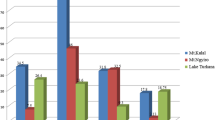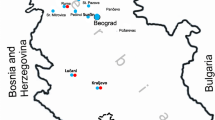Abstract
The West Nile virus (WNV) is a mosquito-borne flavivirus causing meningoencephalitis in humans and animals. Due to their particular susceptibility to WNV infection, horses serve as a sentinel species. In a population of Romanian semi-feral horses living in the Danube delta region, we have analyzed the distribution of candidate polymorphic genetic markers between anti WNV-IgG seropositive and seronegative horses. Thirty-six SNPs located in 28 immunity-related genes and 26 microsatellites located in the MHC and LY49 complex genomic regions were genotyped in 57 seropositive and 32 seronegative horses. The most significant association (pcorr < 0.0002) was found for genotypes composed of markers of the SLC11A1 and TLR4 genes. Markers of five other candidate genes (ADAM17, CXCR3, IL12A, MAVS, TNFA), along with 5 MHC class I and LY49-linked microsatellites were also associated with the WNV antibody status in this model horse population. The OAS1 gene, previously associated with WNV-induced clinical disease, was not associated with the presence of anti-WNV antibodies.

Similar content being viewed by others
References
Chancey C, Grinev A, Volkova E, Rios M (2015) The global ecology and epidemiology of West Nile virus. Biomed Res Int 2015:376230. https://doi.org/10.1155/2015/376230
van der Meulen KM, Pensaert MB, Nauwynck HJ (2005) West Nile virus in the vertebrate world. Arch Virol 150:637–657. https://doi.org/10.1007/s00705-004-0463-z
Bunning ML, Bowen RA, Cropp CB et al (2002) Experimental infection of horses with West Nile virus. Emerg Infect Dis 8:380–386. https://doi.org/10.3201/eid0804.010239
Angenvoort J, Brault AC, Bowen RA, Groschup MH (2013) West Nile viral infection of equids. Vet Microbiol Spec Issue 167:168–180. https://doi.org/10.1016/j.vetmic.2013.08.013
Sejvar JJ (2014) Clinical manifestations and outcomes of West Nile virus infection. Viruses 6:606–623. https://doi.org/10.3390/v6020606
Leblond A, Hendrikx P, Sabatier P (2007) West Nile virus outbreak detection using syndromic monitoring in horses. Vector Borne Zoonotic Dis 7:403–410. https://doi.org/10.1089/vbz.2006.0593
Cahill ME, Conley S, DeWan AT, Montgomery RR (2018) Identification of genetic variants associated with dengue or West Nile virus disease: a systematic review and meta-analysis. BMC Infect Dis 18:282. https://doi.org/10.1186/s12879-018-3186-6
Mashimo T, Lucas M, Simon-Chazottes D et al (2002) A nonsense mutation in the gene encoding 2’-5’-oligoadenylate synthetase/L1 isoform is associated with West Nile virus susceptibility in laboratory mice. Proc Natl Acad Sci USA 99:11311–11316. https://doi.org/10.1073/pnas.172195399
Rios JJ, Fleming JGW, Bryant UK et al (2010) OAS1 polymorphisms are associated with susceptibility to West Nile Encephalitis in horses. PLoS ONE. https://doi.org/10.1371/journal.pone.0010537
Bielefeldt-Ohmann H, Bosco-Lauth A, Hartwig AE et al (2017) Characterization of non-lethal West Nile Virus (WNV) infection in horses: subclinical pathology and innate immune response. Microb Pathog 103:71–79. https://doi.org/10.1016/j.micpath.2016.12.018
Rossini G, Landini MP, Gelsomino F, Sambri V, Varani S (2013) Innate host responses to West Nile virus: implications for central nervous system immunopathology. World J Virol 2:49–56. https://doi.org/10.5501/wjv.v2.i2.49
Ludu Oslobanu EL, Mihu-Pintilie A, Anită D, Anita A, Lecollinet S, Savuta G (2014) West Nile virus reemergence in Romania: a serologic survey in host species. Vector Borne Zoonotic Dis 14:330–337. https://doi.org/10.1089/vbz.2013.1405
Sirbu A, Ceianu CS, Panculescu-Gatej RI et al (2011) Outbreak of West Nile virus infection in humans, Romania, July to October 2010. Euro Surveil. https://doi.org/10.25646/727
Stejskalova K, Janova E, Horecky C, Horecka E, Vaclavek P, Hubalek Z, Relling K, Cvanova M, D’Amico G, Mihalca AD, Modry D, Knoll A, Horin P (2019) Genetic susceptibility to West Nile virus infection in Camargue horses. Res Vet Sci 124:284–292. https://doi.org/10.1016/j.rvsc.2019.04.004
Gâştescu P (2012) The Danube Delta Biosphere Reserve. Geography, biodiversity, protection, management. Water resources and wetlands conference proceedings 2012:431–442
Dinu S, Cotar AI, Pănculescu-Gătej IR, Fălcuţă E, Prioteasa FL, Sîrbu A, Oprişan G, Bădescu D, Reiter P, Ceianu CS (2015) West Nile virus circulation in South-Eastern Romania, 2011 to 2013. Euro Surveillance 20:21130
Perkins NJ, Schisterman EF (2006) The inconsistency of “optimal” cutpoints obtained using two criteria based on the receiver operating characteristic curve. Am J Epidemiol 163:670–675. https://doi.org/10.1093/aje/kwj063
Stejskalova K, Janova E, Horecky C et al (2019), Associations between West Nile Virus infection and candidate genes in Romanian horses from the Danube delta: not only OAS1 [dataset] Supplementary files, Mendeley Data, v3
Vychodilova L, Matiasovic J, Bobrova O et al (2013) Immunogenomic analysis of insect bite hypersensitivity in a model horse population. Vet Immunol Immunopathol 152:260–268. https://doi.org/10.1016/j.vetimm.2012.12.013
Horecky C, Horecka E, Futas J, Janova E, Horin P, Knoll A (2018) Microsatellite markers for evaluating the diversity of the natural killer complex and major histocompatibility complex genomic regions in domestic horses. HLA 91:271–279. https://doi.org/10.1111/tan.13211
Purcell S, Neale B, Todd-Brown K et al (2007) PLINK: a tool set for whole-genome association and population-based linkage analyses. Am J Hum Genet 81:559–575. https://doi.org/10.1086/519795
Wigginton JE, Cutler DJ, Abecasis GR (2005) A note on exact tests of Hardy-Weinberg equilibrium. Am J Hum Genet 76:887–893. https://doi.org/10.1086/429864
Pagano M, Gauvreau K (2000) Principles of biostatistics, 2nd edn. Brooks/Cole, Belmont
Deeks JJ, Higgins JPT (2010) Statistical algorithms in Review Manager 5. https://www.researchgate.net/publication/252093205_Statistical_Algorithms_in_Review_Manager_5. Accessed 5 Dec 2018
de Wit E, van der Merwe L, van Helden PD, Hoal EG (2011) Gene-gene interaction between tuberculosis candidate genes in a South African population. Mamm Genome 22:100–110. https://doi.org/10.1007/s00335-010-9280-8
Ghlichnia HA, Kollaee A, Gaffarpoor M, Movafagh A, Ghlichnia B, Zamani M (2014) The influence of combined genotypes of the HLADRB1*1501 and CD24 single nucleotide polymorphism on disease severity of Iranian multiple sclerosis patients. Acta Med Iran 52:418–423
Ostlund EN, Crom RL, Pedersen DD, Johnson DJ, Williams WO, Schmitt BJ (2001) Equine West Nile encephalitis, United States. Emerg Infect Dis 7:665–669
Cotar AI, Falcuta E, Prioteasa LF, Dinu S, Ceianu CS, Paz S (2016) Transmission dynamics of the West Nile virus in mosquito vector populations under the influence of weather factors in the Danube Delta, Romania. EcoHealth 13:796–807. https://doi.org/10.1007/s10393-016-1176-y
Sarri CA, Markantoni M, Stamatis C et al (2016) Genetic contribution of MHC Class II genes in susceptibility to West Nile Virus infection. PLoS ONE 11:e0165952. https://doi.org/10.1371/journal.pone.0165952
Lazear HM, Diamond MS (2015) New Insights into Innate immune restriction of West Nile virus infection. Curr Opin Virol 11:1–6. https://doi.org/10.1016/j.coviro.2014.12.001
Necesankova M, Vychodilova L, Albrechtova K et al (2016) MYD88 and functionally related genes are associated with multiple infections in a model population of Kenyan village dogs. Mol Biol Rep 43:1451–1463. https://doi.org/10.1007/s11033-016-4078-8
Balding DJ (2006) A tutorial on statistical methods for population association studies. Nat Rev Genet 7:781–791. https://doi.org/10.1038/nrg1916
Soares MP, Weiss G (2015) The Iron age of host-microbe interactions. EMBO Rep 16:1482–1500. https://doi.org/10.15252/embr.201540558
Modhiran N, Watterson D, Muller DA et al (2015) Dengue virus NS1 protein activates cells via Toll-like receptor 4 and disrupts endothelial cell monolayer integrity. Sci Transl Med 7:304ra142. https://doi.org/10.1126/scitranslmed.aaa3863
Quicke KM, Suthar MS (2013) The innate immune playbook for restricting West Nile virus infection. Viruses 5:2643–2658. https://doi.org/10.3390/v5112643
Uddin MJ, Suen WW, Prow NA, Hall RA, Bielefeldt-Ohmann H (2015) West Nile virus challenge alters the transcription profiles of innate immune genes in rabbit peripheral blood mononuclear cells. Front Vet Sci 2:76. https://doi.org/10.3389/fvets.2015.00076
Galdino H, Saar Gomes R, Dos Santos JC, Pessoni LL, Maldaner AE, Marques SM et al (2016) Leishmania (Viannia) braziliensis amastigotes induces the expression of TNFα and IL-10 by human peripheral blood mononuclear cells in vitro in a TLR4-dependent manner. Cytokine 88:184–192. https://doi.org/10.1016/j.cyto.2016.09.009
Wessling-Resnick M (2015) Nramp1 and other transporters involved in metal withholding during infection. J Biol Chem 290:18984–18990. https://doi.org/10.1074/jbc.R115.643973
Bayerova Z, Janova E, Matiasovic J, Orlando L, Horin P (2016) Positive selection in the SLC11A1 gene in the family Equidae. Immunogenetics 68:353–364. https://doi.org/10.1007/s00251-016-0905-2
Oexle H, Kaser A, Möst J, Bellmann-Weiler R, Werner ER, Werner-Felmayer G, Weiss G (2003) Pathways for the regulation of interferon-γ-inducible genes by iron in human monocytic cells. J Leukoc Biol 74:287–294. https://doi.org/10.1189/jlb.0802420
Hedges JF, Kimmel E, Snyder DT, Jerome M, Jutila MA (2013) SLC11A1 is expressed by innate lymphocytes and augments their activation. J Immunol 190:4263–4273. https://doi.org/10.4049/jimmunol.1200732
Fritsche G, Nairz M, Werner ER, Barton HC, Weiss G (2008) Nramp1-functionality increases iNOS expression via repression of IL-10 formation. Eur J Immunol 38:3060–3067. https://doi.org/10.1002/eji.200838449
Awomoyi AA, Marchant A, Howson JMM, McAdam KPWJ, Blackwell JM, Newport MJ (2002) Interleukin-10, polymorphism in SLC11A1 (formerly NRAMP1), and susceptibility to tuberculosis. J Infect Dis 186:1808–1814. https://doi.org/10.1086/345920
Strauss-Albee DM, Fukuyama J, Liang EC et al (2015) Human NK cell repertoire diversity reflects immune experience and correlates with viral susceptibility. Sci Transl Med 7:297ra115. https://doi.org/10.1126/scitranslmed.aac5722
Wang T, Welte T (2013) Role of natural killer and Gamma-delta T cells in West Nile virus infection. Viruses 5:2298–2310. https://doi.org/10.3390/v5092298
Parham P, Norman PJ, Abi-Rached L, Guethlein LA (2012) Human-specific evolution of killer cell immunoglobulin-like receptor recognition of major histocompatibility complex class I molecules. Philos Trans R Soc Lond B 367:800–811. https://doi.org/10.1098/rstb.2011.0266
Futas J, Horin P (2013) Natural killer cell receptor genes in the family Equidae: not only Ly49. PLoS ONE 8:e64736. https://doi.org/10.1371/journal.pone.0064736
Zhou YQ, Liu DQ, Chen SP, Sun J, Zhou XR, Xing C, Ye DW, Tian YK (2019) The role of CXCR48 in neurological diseases. Curr Neuropharmacol 17:142–150. https://doi.org/10.2174/1570159X15666171109161140
Koper OM, Kamińska J, Sawicki K, Kemona H (2018) CXCL9, CXCL10, CXCL11, and their receptor (CXCR1) in neuroinflammation and neurodegeneration. Adv Clin Exp Med 27:849–856
Acknowledgements
This research was supported by the Central European Institute of Technology (CEITEC) CZ.1.05/1.1.00/02, and by the Ministry of Education, Youth and Sports of the Czech Republic, project CEITEC 2020 [the Czech National Sustainability Programme NPU LQ1601, Grant No. LQ1601]. The work of ADM and GA was supported by the Grant UEFISCDI PCCDI 57/2018.
Author information
Authors and Affiliations
Corresponding author
Ethics declarations
Conflict of interest
The authors declare that they have no conflict of interest.
Ethical approval
All blood samples were collected primarily for veterinary surveillance purposes, as part of the Romanian national strategic plan for diseases surveillance. All samplings were conducted by licensed veterinarians in compliance with all legal, ethical and professional standards and following the verbal consent of all owners.
Additional information
Publisher's Note
Springer Nature remains neutral with regard to jurisdictional claims in published maps and institutional affiliations.
Rights and permissions
About this article
Cite this article
Stejskalova, K., Janova, E., Horecky, C. et al. Associations between the presence of specific antibodies to the West Nile Virus infection and candidate genes in Romanian horses from the Danube delta. Mol Biol Rep 46, 4453–4461 (2019). https://doi.org/10.1007/s11033-019-04900-w
Received:
Accepted:
Published:
Issue Date:
DOI: https://doi.org/10.1007/s11033-019-04900-w




